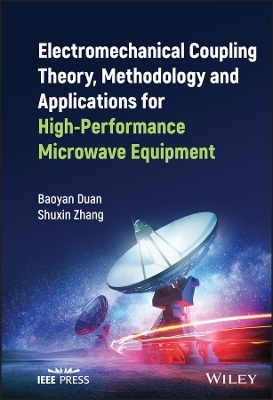
Electromechanical Coupling Theory, Methodology and Applications for High-Performance Microwave Equipment
Wiley-IEEE Press (Verlag)
978-1-119-90439-7 (ISBN)
The book is divided into four main sections, beginning with an introduction to electromechanical coupling (EMC) theory and a detailed description of the multi-field coupling model (MFCM) and the influence mechanism (IM) of nonlinear factors of antenna-servo-feeder systems on performance. Subsequent sections discuss MFCM- and IM-based design methodology, EMC-based measurement and testing, computer software for coupling analysis and design of electronic equipment, and various engineering applications of EMC theory and the IM of typical electronic equipment. In addition, the book:
Discusses information and data transfer in electromagnetic fields, mechanical and structural deformation fields, and temperature fields
Explains how high-performance microwave electronic equipment differs from traditional mechanical equipment
Addresses EMC-based and general design-vector based optimization of electronic equipment design
Describes applications such as a gun-guided radar system for warships and a large-diameter antenna for moon exploration
Includes evaluation criteria to validate MFCM/IM design theory and methodology
Electromechanical Coupling Theory, Methodology, and Applications for High-Performance Microwave Equipment is essential reading for circuit designers, microwave engineers, researchers working with high-frequency microwave engineering, and engineers working with integrated circuits in radar, communications, IoT, antenna engineering, and remote sensing.
Baoyan Duan, PhD, is an Academician of the Chinese Academy of Engineering (CAE) and a Full Professor of Electromechanical Engineering at Xidian University (XDU), China. He is Chair of the Antenna Industry Alliance (AIA) of China, Fellow of the Institute of Engineering and Technology (IET), and Editor-in-Chief of Electromechanical Engineering of China. Professor Duan has published 200 papers, 6 books, and 40 patents. Shuxin Zhang, PhD, is a Professor of Electromechanical Engineering in the Key Laboratory of Electronic Equipment Structure (Ministry of Education) at Xidian University, China. Professor Zhang’s research interests include integrated structural-electromagnetic analysis, optimization design of reflector antennas, and structural and multidisciplinary design of deployable antennas.
1 Background of electromechanical coupling of electronic equipment
1.1 Introduction
1.2 Characteristics of electronic equipment
1.3 Components of electronic equipment
1.4 On research of electromechanical coupling (EMC) of electronic Equipment
1.5 Problem of the traditional design method of electronic equipment
1.6 Main science and technology respects of design for electronic equipment
1.7 Mechatronics marching toward coupling between mechanical and electronic technologies
References
Chapter 2 Fundamental of establishing multi-field coupling theoretical model of electronic equipment
2.1 Introduction
2.2 Mathematical description of electromagnetic (EM), structural deformation (S) and Temperature (T) fields
2.3 Consideration of establishing multi-field coupling model
References
Chapter 3 Multi-field coupling models of four kind of typical electronic equipment
3.1 Introduction
3.2 Reflector antennas
3.3 Planar slotted waveguide array antennas
3.4 Active phased array antennas
3.5 High density cabinets
References
Chapter 4 Solving strategy and method of the multi-field coupling problem of electronic equipment
4.1 Introduction
4.2 Solving strategy of the multi-field coupling problem
4.3 Solving method of the multi-field coupling problem
4.4 General approach method of the multi-field coupling problem
4.5 The mesh matching among different fields
4.6 Mesh transformation and information transfer
References
Chapter 5 Influence mechanism (IM) of nonlinear factors of antenna-servo-feeder systems on performance
5.1 Introduction
5.2 Data mining of ISFP
5.3 ISFP of reflector antennas
5.4 ISFP of planar slotted waveguide array antennas
5.5 ISFP of microwave feeder and filters
5.6 ISFP of radar servo mechanism
5.7 ISFP of active phased array antennas with radiating arrays
References
Chapter 6 EMC based measure & test of typical electronic equipment
6.1 Introduction
6.2 EMC based analysis of measure & test factors
6.3 EMC based measure & test technology for typical case
6.4 EMC based measure & test system for typical case
References
Chapter 7 Evaluation on EMC of typical electronic equipment
7.1 Introduction
7.2 On correct of EMC theory and IM
7.3 On validation of EMC theory and IM
7.4 Evaluation of EMC theory and IM for PSAA
7.5 Evaluation of EMC theory and IM for a radar servo mechanism
7.6 Evaluation of EMC theory and IM for filter
References
Chapter 8 EMC & IM based optimum design of electronic equipment
8.1 Introduction
8.2 EMC & IM based reflector optimum design
8.3 EMC & IM based cabinet optimum design
8.4 EMC & IM based radar servo mechanism optimum design
8.5 A general design-vector based optimum design of electronic equipment
References
Chapter 9 Computer software platform for coupling analysis and design of electronic equipment
9.1 Introduction
9.2 General method and system project
9.3 Integration of the professional software
9.4 Software development of EM-S-T field-coupling analysis
9.5 Software development of IM of structural factors on performance
9.6 Software of EMC & IM based measure & test and evaluation
References
Chapter 10 Engineering applications of EMC theory and IM of electronic equipment
10.1 Introduction
10.2 Application of moon-exploration antenna with the diameter of 40 meters
10.3 Application of the servomechanism of the gun-guided radar system in warship
10.4 Application of planar slotted array antennas
10.5 Application of the filter with electrical adjustable and double functioning
10.6 Application of FAST-500m aperture spherical radio telescope
References
Chapter 11 Development trends of electromechanical coupling theory and method of electronic equipment
11.1 Introduction
11.2 Extreme frequencies
11.3 Extreme environments
11.4 Extreme power
References
| Erscheinungsdatum | 09.11.2022 |
|---|---|
| Reihe/Serie | IEEE Press |
| Sprache | englisch |
| Gewicht | 726 g |
| Themenwelt | Technik ► Elektrotechnik / Energietechnik |
| ISBN-10 | 1-119-90439-0 / 1119904390 |
| ISBN-13 | 978-1-119-90439-7 / 9781119904397 |
| Zustand | Neuware |
| Haben Sie eine Frage zum Produkt? |
aus dem Bereich


